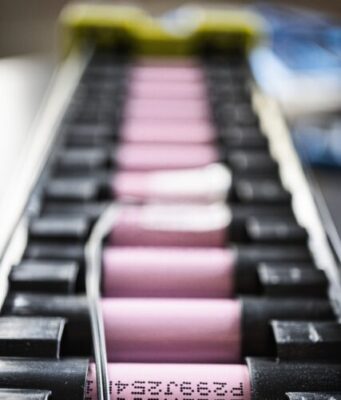Dr Horst Punzmann (left) and Professor Michael Shats in the lab. Credit: Stuart Hay, ANU
Scientists at The Australian National University (ANU) have controlled wave-generated currents to make previously unimaginable liquid materials for new technological innovations, including techniques to manipulate...
Crystal structure of Na2He, resembling a three-dimensional checkerboard. The purple spheres represent sodium atoms, which are inside the green cubes that represent helium atoms. The red regions inside voids of the structure show areas where localized electron pairs reside.Illustration...
A schematic illustration of a microbial fuel cell using a paper electrode coated with carbon paste. Credit: Michael Osadciw/University of Rochester
The concept behind microbial fuel cells, which rely on bacteria to generate an electrical current, is more than a...
Mengjin Yang (left), Kai Zhu, Ye Yang, Matt Beard, David Moore and Elisa Miller are co-authors of a new paper in Nature Energy about perovskites. Credit: Dennis Schroeder / NREL
A team of scientists from the Energy Department's National Renewable...
Stills from a simulation of the properties of one-dimensional boron shows the material that starts as a ribbon transforms into a single-atom chain, until it reaches the breaking point. Rice University scientists discovered the still-theoretical material would have unique...
MIT chemical engineers have developed arrays of carbon nanotube sensors that can detect single protein molecules as they are secreted from cells.Credit: Massachusetts Institute of Technology
Modified carbon nanotubes could be used to track protein production by individual cells.
For the...
A diagram showing cholesterol's (red) predominance in the outer layer of the cell membrane. Cholesterol transport proteins (blue) can alter its distribution between the inner and outer layers. Credit: UIC
Scientists have long puzzled over cholesterol. It's biologically necessary; it's...
Before and after demonstration of filter's ability. Credit: WSU
Washington State University researchers have developed a soy-based air filter that can capture toxic chemicals, such as carbon monoxide and formaldehyde, which current air filters can't.
The research could lead to better...
Open and closed forms of channel proteins, which function by changing their shape. Credit: University of Arkansas
A University of Arkansas chemist and his collaborator at North Carolina State University have developed a new theory for explaining how proteins and...
New research shows that when metal oxide (flat array of atoms at bottom) is used as a catalyst for splitting water molecules, some of the oxygen produced comes out of the metal oxide itself, not just from the surrounding...
Illustration shows the delivery route of hydrogen sulfide to damaged cells based on two projects completed in the University of Oregon lab of Michael Pluth. Credit: Michael Pluth
Molecules with the potential to deliver healing power to stressed cells -...


















